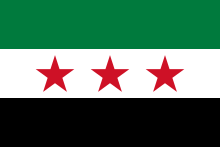
Back القومية السورية Arabic Suriya milliyətçiliyi Azerbaijani ناسیۆنالیزمی سووری CKB Pansyrismus German Nacionalismo sirio Spanish ملیگرایی سوری Persian Nationalisme syrien French Սիրիական ազգայնականություն Armenian Nasionalisme Suriah ID 大シリア主義 Japanese


Syrian nationalism (Arabic: القَومِيَةُ السُورِيَّةُ, romanized: al-qawmīyah as-Sūriyyah), also known as pan-Syrian nationalism or pan-Syrianism (Arabic: الوَحْدَةُ الشَّامِيَةُ, romanized: al-waḥda ash-Shāmiyyah), refers to the nationalism of the region of Syria, as a cultural or political entity known as "Greater Syria," known in Arabic as Bilād ash-Shām (Arabic: بِلَاد الـشَّـام).[1]
Syrian nationalism originated with the Arab Revolt against the Ottoman Empire during World War I.[2] While most "pragmatic" Syrian nationalists advocate for Arab nationalism and view pan-Syrianism as a step toward a broader pan-Arab state, a minority of "pure" Syrian nationalists, often associated with the Syrian Social Nationalist Party, oppose this perspective. They assert that Syria should be the leading force among the Arab people and reject pan-Arabist movements that would position all Arabs on the same level.[3][4]
Some Syrian opposition forces who were fighting against the Assad regime government are strong advocates of historical Syrian nationalism that hearkens back to a "Golden Age." The Free Syrian Army has incorporated symbols of nationalist insignia into their flags and military uniforms during the Syrian civil war.[5] Syrian nationalism was historically prominent in Lebanon, where it was particularly widespread among Lebanese Sunni Muslims, who aspired to be incorporated into a Greater Syrian state.[6]
- ^ Kamal S. Salibi (2003). A House of Many Mansions: The History of Lebanon Reconsidered. I.B.Tauris. pp. 61–62. ISBN 978-1-86064-912-7.
To the Arabs, this same territory, which the Romans considered Arabian, formed part of what they called Bilad al-Sham, which was their name for Syria. From the classical perspective Syria, including Palestine, formed no more than the western fringes of what was reckoned to be Arabia between the first line of cities and the coast. Since there is no clear dividing line between what is called today the Syrian and Arabian deserts, which form one stretch of arid tableland, the classical concept of what constituted Syria had more to its credit geographically than the vaguer Arab concept of Syria as Bilad al-Sham. Under the Romans, there was a province of Syria, with its capital at Antioch, which carried the name of the territory. Otherwise, down the centuries, Syria like Arabia and Mesopotamia, was no more than a geographic expression. In Islamic times, the Arab geographers used the name Arabicized as Suriyah, to denote one special region of Bilad al-Sham, which was the middle section of the valley of the Orontes river, in the vicinity of the towns of Homs and Hama. They also noted that it was an old name for the whole of Bilad al-Sham which had gone out of use. As a geographic expression, however, the name Syria survived in its original classical sense in Byzantine and Western European usage, and also in the Syriac literature of some of the Eastern Christian Churches, from which it occasionally found its way into Christian Arabic usage. It was only in the nineteenth century that the use of the name was revived in its modern Arabic form, frequently as Suriyya rather than the older Suriyah, to denote the whole of Bilad al-Sham: first of all in the Christian Arabic literature of the period, and under the influence of Western Europe. By the end of that century, it had already replaced the name of Bilad al-Sham even in Muslim Arabic usage.
- ^ Di-Capua, Yoav (2009-09-09). Gatekeepers of the Arab Past: Historians and History Writing in Twentieth-Century Egypt. Univ of California Press. p. 254. ISBN 978-0-520-94481-7.
- ^ Záhořík, Jan; Morone, Antonio M. (2022-07-08). Histories of Nationalism beyond Europe: Myths, Elitism and Transnational Connections. Springer Nature. p. 41. ISBN 978-3-030-92676-2.
- ^ Cite error: The named reference
Pipes 1988 radicalwas invoked but never defined (see the help page). - ^ J. Gilbert, Victoria (2013). Syria for the Syrians: The Rise of Syrian Nationalism, 1970-2013 (PDF). Boston, Massachusetts, USA: Northeastern University. pp. 54–64, 67–81. Archived from the original (PDF) on 8 April 2023.
- ^ Pipes, Daniel (1992-03-26). Greater Syria: The History of an Ambition. Oxford University Press. p. 63. ISBN 978-0-19-536304-3.
Still, a reluctance fully to accept the Lebanese polity remained widespread among Sunni Lebanese. The case of the prominent Karami family of Tripoli illustrates the continuity of this sentiment. 'Abd al-Hamid Karami, a Sunni mufti, wrote to the president of France in June 1937 demanding the incorporation of Tripoli and its region into the "motherland" of Syria; it was not until 1949, after he had been Lebanon's prime minister for four years, that he accepted the National Pact of 1943–and then only with reservations.